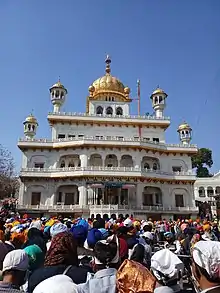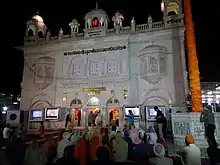
| Part of a series on |
| Sikhism |
|---|
 |
A takht, or taḵẖat (Punjabi: ਤਖ਼ਤ), literally means a throne or seat of authority[1] and is a spiritual and temporal centre of Sikhism.[2] There are five takhts (Punjabi: ਪੰਜ ਤਖਤ, romanized: Pañj takhat, lit. 'five thrones'), which are five gurudwaras that have a very special significance for the Sikh community. Three are located in Punjab whilst the remaining two are located outside of it.[3]
The first and the most important takht was established by Guru Hargobind in 1609: Akal Takht (the Throne of the Timeless God), located just opposite the gate of Harmandir Sahib (The Golden Temple), in Amritsar. While the Harmandir Sahib, or Golden Temple, represents Sikh spiritual guidance, the Akal Takht symbolizes the dispensing of justice and temporal activity. It is the highest seat of temporal authority of the Khalsa and the seat of the Sikh religion's earthly authority. There, the Guru held his court and decided matters of military strategy and political policy. Later on, the Sikh Nation (Sarbat Khalsa) took decisions here on matters of peace and war and settled disputes between the various Sikh groups. The Sarangi singers sung the ballads of the Sikh Gurus and warriors at the place and robes of honour (saropas) were awarded to persons who rendered distinguished services of the community of men in general.
In December 2010, the Deccan Odyssey train, taken on charter from the Government of Maharashtra, started with the aim to have a journey across four Sikh takhts, with a flight by devout and sightseers to the fifth takht (Takht Sri Patna Sahib).[4] A special train for the pilgrimage to the five takhts, named Panj Takht Special Train, began service on 16 February 2014.[5][6][7][8][9]
Akal Takht
Akal Takhat Sahib means Eternal Throne. It is also part of the Golden Temple complex in Amritsar. Its foundation was laid by Guru Hargobind, the sixth Sikh guru.[2] The Akal Takhat is situated opposite to Harmandir Sahib and is connected by a passage. The building of the Akal Takht opposite the Golden Temple has a special meaning. While the Golden Temple stands for spiritual guidance the Akal Takhat symbolizes the dispensing of justice and temporal activity. In earlier days all Sikh warriors sought blessings here before going to battle fields. During the 18th century while Sikhs were fighting a guerrilla war in the forests they used to gather at the Akal Takht on special occasions such as Vaisakhi. Here the community used to have general meetings and approve resolutions. The Akal Takht is the oldest of the Five Takhats.
Takht Keshgarh Sahib
Takht Sri Keshgarh Sahib is situated at Anandpur Sahib. It is the birthplace of the Khalsa, which was founded here by Guru Gobind Singh in 1699. Some of the weapons of Guru Gobind Singh are displayed here.
Takht Damdama Sahib

Takht Sri Damdama Sahib (Talwandi Sabo) is situated in the village of Talwandi Sabo near Bathinda.[10] Guru Gobind Singh stayed here for about a year and compiled the final edition of Guru Granth Sahib also known as the Damdama Sahib Bir in 1705.[11] Damdama Sahib was proclaimed the fifth takht on November 18, 1966.[12]
Takht Patna Sahib
Takht Sri Patna Sahib is situated in Patna city which is also the capital of Bihar state.[3] Guru Gobind Singh was born here in 1666 and He spent His early childhood here before moving to Sri Anandpur Sahib.[13][14] Besides being the birthplace of Guru Gobind Singh,[15] Patna was also visited by Guru Nanak and Guru Tegh Bahadur at different points of time. Here also stayed Guru Gobind Singh's mother, Mata Gujri and it was house of Salis Rai Johri.
Takht Hazur Sahib
Takht Sri Hazur Sahib is situated in Nanded in Maharashtra state on the bank of river godavari.[3] In 1708, Guru Gobind Singh (the tenth spiritual leader of the Sikhs) came to Nanded, permanent abode. It was he who preached amongst the Sikhs that there need not be any Human Guru for them after Him and they should take Guru Granth Sahib as their living Guru and there will be no difference between Him and the Guru Granth Sahib. A monument has been constructed at the place where Guru Gobind Singh left his body to merge with the omnipresent, known as the Angitha Sahib (funeral pyre). The Takht has been constructed around the Angitha Sahib, and is collectively known as Takht Sachkand Sri Hazoor Sri Abchal Nagar Sahib.
Others
Contested
Takht Budha Dal
According to the Budha Dal organization of Nihangs, the Budha Dal is the fifth takht.[16] They state that the Guru proclaimed them the fifth takht and the SGPC removed them as the fifth takht. Mahant Sumer Singh Patna Sahib mentions the Panth Khalsa as a Chakrvarti takht in his Gur Pad Prem Parkash and so do other historical sources .
Potential
Gurudwara Janam Asthan
.jpg.webp)
A proposal for a sixth Sikh takht at Guru Nanak Dev’s birth place in Nankana Sahib in Pakistan has sparked a debate in the Sikh community, and among historians and scholars.[17]
Shiromani Akali Dal (Delhi) president and former president of Delhi Sikh Gurdwara Management Committee (DSMGC) Paramjit Singh Sarna has stirred a controversy by demanding that Gurdwara Janamasthan Nankana Sahib in Pakistan be declared the sixth takht (seat of authority) of Sikhs. Acting jathedar of Akal Takht, Giani Harpreet Singh was the first to censure the demand, saying: “This is a baseless demand which belittles the concept of Panch Pardhani (significance of five) in Sikhism like five articles of faith, five beloved ones (Panj Payaras) and five bania.” The proposal was ignored afterwards.
References
- ↑ "New Persian-English Dictionary". dsal.uchicago.edu. Chicago University. Archived from the original on 1 September 2023. Retrieved 1 September 2023.
- 1 2 Dogra, R. C.; Mansukhani, Gobind Singh (1995). Encyclopaedia of Sikh Religion and Culture. Vikas Publishing House. p. 356. ISBN 9780706983685.
- 1 2 3 Chandra, Aditi; Chandra, Vinita (2019). The Nation and Its Margins: Rethinking Community. Cambridge Scholars Publishing. p. 80. ISBN 9781527544574.
- ↑ "A luxury train trip across Sikh takhts". December 13, 2010.
- ↑ "Singla flags off Panj Takht Special Train for pilgrims at Dhuri". Hindustan Times. February 16, 2014.
- ↑ "Now, Shatabdi to halt at Dhuri". Hindustan Times. February 9, 2014.
- ↑ "Union railway ministry: Special train to connect all five Takhats, first run on February 16 | Chandigarh News - Times of India". The Times of India.
- ↑ "IRCTC launches special train to cover all Pank Sikh Takhts". Hindustan Times. March 11, 2014.
- ↑ "Train to cover Panj Takhts from Chandigarh next week". Hindustan Times. April 11, 2014.
- ↑ Johar, Surinder Singh (1998). Holy Sikh Shrines. M.D. Publications Pvt. Ltd. p. 88. ISBN 9788175330733.
- ↑ Singha, H. S. (2000). The Encyclopedia of Sikhism (over 1000 Entries). Hemkunt Press. p. 51. ISBN 9788170103011.
- ↑ "Sikh Encyclopedia". Sikh Encyclopedia.
- ↑ Mona Mehta. "The tenth Guru was born here". The Times of India.
- ↑ "Five jathedars visit Patna, kick off '17 preparations | Patna News - Times of India". The Times of India.
- ↑ "Takhat Saheb set for prakashotsav | Patna News - Times of India". The Times of India.
- ↑ "Homepage of Budha Dal official website". Budha Dal. Retrieved 30 June 2023.
The Budha Dal were blessed with the duties of maintaining rule within the Khalsa Panth and preserve and protect the Gurdwaras and Ithihasik Asthaans throughout Punjab. The Budha Dal used to be the institute where the Vidhvaans who held a lineage which dated back to the Gurus rested. Also, war veterans and promising soldiers resided at the Budha Dal. The Budha Dal was traditionally respected and recognised as the Panjva Takhat, or 5th Takhat. This was due to the immense power the Budha Dal held. It was recognised to such an extent that the renowned and legendary Jathedar Akali Baba Phoola Singh Ji, the 6th Jathedar of the Budha Dal and the General of Maharaja Ranjit Singh's Army, ordered punishment for Maharaja Ranjit Singh for breaking a conduct of the Sikh Dharam.
- ↑ "Explained: The role of the 5 Sikh takhts, and the debate over a proposal for a 6th". The Indian Express. 2018-12-06. Retrieved 2021-01-10.
External links
Official Website - HOLY TAKHATS



